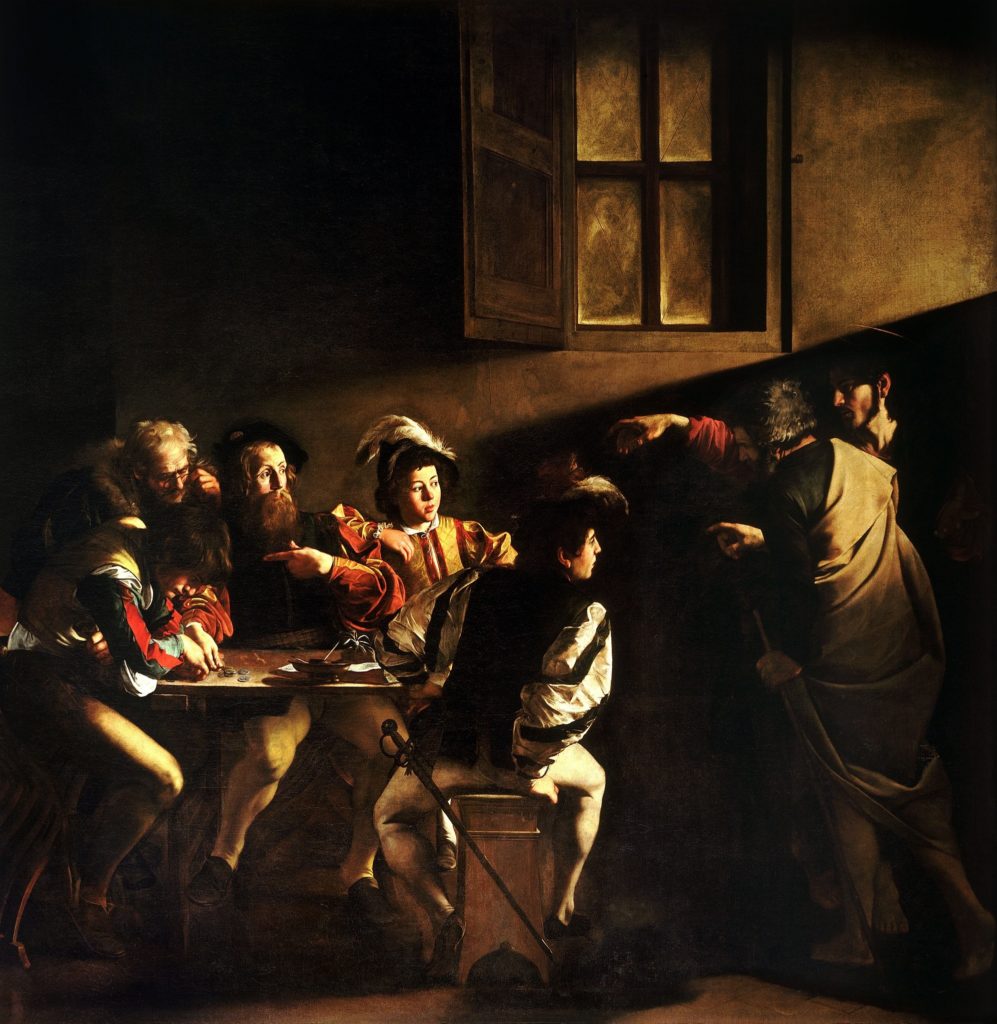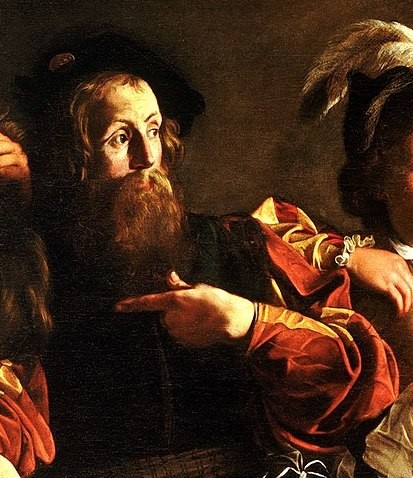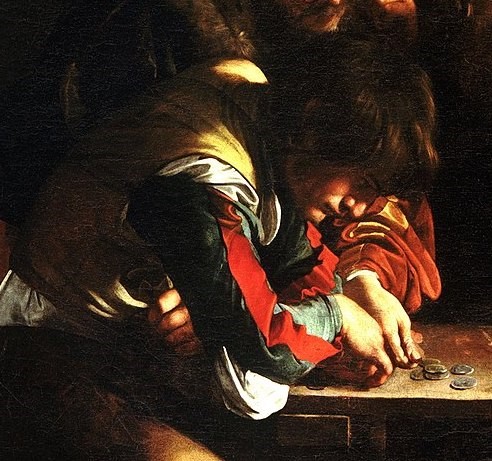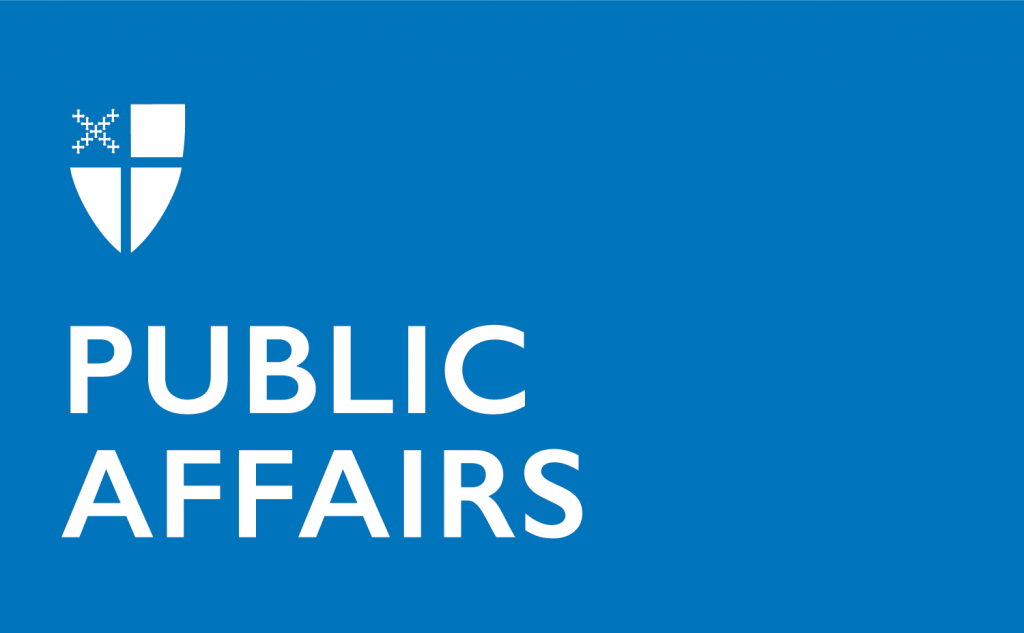80th General Convention of The Episcopal Church: July 9 sermon by the Rev. Gay Clark Jennings, President of the House of Deputies
The following is the text of a sermon recorded by the Rev. Gay Clark Jennings, president of the House of Deputies, for the July 9 Morning Prayer service of the 80th General Convention of The Episcopal Church, meeting in Baltimore through July 11.
In the name of God, amen.
Like a lot of you, I like to consult a few commentaries before I preach, and this time around the best commentary wasn’t done on a page, but on a canvas.
Have a look.
80ª Convención General de la Iglesia Episcopal: Sermón del 9 de Julio pronunciado por la Reverenda Gay Clark Jennings, presidenta de la Cámara de Diputados
El siguiente es el texto de un sermón grabado por la Reverenda Gay Clark Jennings, presidenta de la Cámara de Diputados, para el servicio de Oración Matutina del 9 de julio de la 80ª Convención General de la Iglesia Episcopal, que se reúne en Baltimore hasta el 11 de Julio.
En el nombre de Dios, amén.
Como muchos de ustedes, me gusta consultar algunos comentarios antes de predicar, y esta vez el mejor comentario no se hizo en una página, sino en un lienzo.
Echen un vistazo.

This is “The Calling of St. Matthew” by Caravaggio.
You will recognize Jesus and Peter on the right. The young guy with the black-and-white-striped sleeves is a bodyguard. I’ll say more about the other four figures in a moment.
Sometimes an image makes visible lessons we don’t necessarily find in a text, no matter how many times we have read it. This particular painting makes several things jump out at me, and I wanted to share them with you.
The first is that Jesus goes into dangerous places.
If you were a Jewish man drawing large crowds for any reason in the Roman Empire, you were under suspicion. So Jesus was no stranger to risk, even before his final entry into Jerusalem. And he is at risk here. The room in which Matthew and his associates have met is dark. It’s private. It’s out of the way. The business they are conducting requires a bodyguard.
And let’s take a look at the bodyguard. He is leaning forward. He’s reaching for his weapon. He’s ready to spring.
Jesus and Peter would have known they were at risk before they entered the room. But they went anyway because someone in that room had a calling, and who else was going to let him know?
The second point is that Jesus does not get everyone’s attention.
Despite what must have been a dramatic entrance, not all eyes are on him.
The Son of God is standing in the corner of the room, and the guy in the fur and glasses at the upper left is still looking at the money on the table. The seated figure in the brightly striped sleeves is also staring at the table, clutching a purse, and fingering coins. Even the bearded man with his eyes on Jesus still has his hands on the money he is counting.
Even in God’s presence, people can decide that they have other things to do, other commitments to maintain, other business to transact. It probably goes without saying that at various times in our lives, we have all been such people.
But we are fortunate, because—and here is my third point—Jesus interrupts people.
This painting captures an intrusion. Whatever one thinks of the crew at the table, they are going about their business, and Jesus and Peter just show up to disrupt the proceedings. They invite themselves in and tell one of the men he is needed, and it’s time to go.
None of these guys woke up on the morning of this encounter thinking, “Boy, it would be great if I were to be called to a life-changing adventure of unfathomable spiritual depth,” but that’s what happened.
I am not suggesting that every call to follow Jesus is sudden and dramatic. None of us walk around in a world lit as dramatically as this painting. I am only saying that the promptings of God are often unexpected and dislocating. They come when we are doing other things that had previously given our lives shape and purpose.
A fourth lesson I draw from this painting is that God calls seemingly unpromising people into divine service.
Again, I ask you to look at these men. They are seekers after riches and status. Only one has so much as lifted his eyes to acknowledge Jesus’ presence. They may not have been regarded, as Matthew the tax collector surely was, as a man who preyed upon people of Israel for the benefit of the Roman emperor and his own enrichment, but we are not looking at Francis of Assisi and his original followers either.
Yet here, Jesus, with his luminous outstretched hand, saying, “You’re with me now.”
One of the mysteries of this painting is which of these men Jesus is calling.
Most scholars seem to believe it is the bearded man, with the upraised hand—the idea being that he is pointing to his own chest, as if to say, “Are you talking to me?” Or perhaps more likely, “You can’t possibly be talking to me. Can you?”
Others think Jesus is pointing at our friend across the table with the striped sleeves and the downcast eyes. They believe that all of the many pointing fingers in this painting are pointed at him, and that what we are seeing is the moment before he lifts his eyes from the work that has defined him and understands that his life is about to be transformed.
Now, as you may know, I am not an art historian. I learned what I know about this painting using time-honored tools of historical research, by which I mean Google and YouTube. So, I am not going to venture an interpretation, but if you will indulge my fascination with this painting just a little further, I ask you to imagine yourself as one of the characters at the table. When the divine comes into your midst, are you crouched and defensive, ready with your weapon? Are you wary like the boy in gold and red, who is leaning against the bearded man for protection? Do you sense the significance of the moment but wonder if God could possibly be calling you? Do you find yourself unable to pay proper attention because you are so focused on the task at hand? Or do you find that you can’t take your eyes off things you can count?
Now shift to the other side of the room. It may be uncomfortable to imagine yourself as Jesus. I hope it is uncomfortable for you to imagine yourself as Jesus, so all right, let’s look at Peter instead. He is calling whichever of these men Christ means to call. He is summoning. It’s something a little firmer than an invitation, isn’t it? It’s more like, “You. Now.”
In a few hours, the House of Deputies will elect my successor, and on Monday I will end my 10 years of service as president. It’s a time when people ask you retrospective sorts of questions, such as which of the many things that happened during my long tenure am I proudest of.
I have a list. I have a list.
Not really, I don’t really have a list.
I was thrilled and honored to be in the chair when the House of Deputies approved the resolutions that made marriage equality a reality in most of the dioceses of our church in 2015.
I was gratified by the work I helped initiate through the #MeToo committee that served in advance of the 2018 General Convention.
And I am in hopes that the creation of the Episcopal Coalition for Racial Equity and Justice through the passage of Resolution A125, will be among the most significant actions this church has ever taken.
But what I am proudest of are the people I have had the opportunity to call into leadership. There has been a generational change in our church. The houses of General Convention are more racially diverse than they have ever been. A new generation of young leaders is on the rise in our legislative committees, thanks, in part, I would like to think, to the creation of additional leadership positions which I filled exclusively with younger deputies. At this convention we are focusing special attention on the House of Deputies Committee on the State of the Church, which was composed almost entirely of millennial leaders.
And while I do not know who the House of Deputies will elect as my successor, I do know that, thanks to the decision reached at the 79th General Convention to compensate the person who holds this position, you will be choosing from the youngest and most diverse slate in the church’s history.
We have made significant progress in opening leadership positions in the House of Deputies to people who might previously have been excluded. But more remains to be done. Because if one learns anything in this job—which involves making hundreds and hundreds of appointments—it is that the Spirit not only blows where it will, but upon whom it will.
Like this guy.
Este es “El llamado de San Mateo” de Caravaggio.
Reconocerán ustedes a Jesús y a Pedro a la derecha. El joven con las mangas de rayas blancas y negras es un guardaespaldas. Abordaré las otras cuatro figuras en un momento.
A veces una imagen hace visibles lecciones que no necesariamente encontramos en un texto, sin importar cuántas veces lo hayamos leído. Esta pintura en particular posee varias cosas que me llaman la atención, y quería compartirlas con ustedes.
La primera es que Jesús va a lugares peligrosos.
Si usted fuera un hombre judío que atrae grandes multitudes por cualquier razón en el Imperio Romano, usted estaría bajo sospecha. Así que Jesús no era ajeno al riesgo, incluso antes de su entrada final en Jerusalén. Y él se encuentra en riesgo aquí. La habitación en la que Mateo y sus socios se han reunido es oscura. Es privada. Está apartada del camino. El negocio que están llevando a cabo requiere un guardaespaldas.
Echemos un vistazo al guardaespaldas. Se inclina hacia adelante. Él está buscando su arma. Está listo para tomar un brinco.
Jesús y Pedro habrían sabido que estaban en riesgo antes de entrar a la habitación. Pero fueron de todos modos porque alguien en esa habitación tenía una vocación, y ¿quién más se lo iba a decir?
El segundo punto es que Jesús no recibe la atención de todos.
A pesar de lo que debió haber sido una entrada dramática, no todos los ojos están en él.
El Hijo de Dios está de pie en la esquina de la habitación, y el hombre con el abrigo de piel y lentes de la parte superior izquierda todavía tiene su mirada sobre el dinero en la mesa. La figura sentada con el atuendo de rayas brillantes también está mirando fijamente a la mesa, agarrando un bolso, y digitando monedas. Hasta el hombre barbudo con su mirada encima de Jesús todavía tiene sus manos en el dinero que está contando.
Incluso en la presencia de Dios, las personas pueden decidir que tienen otras cosas que hacer, otros compromisos que cumplir, otros asuntos que manejar. Probablemente no hace falta decir que en varias ocasiones en nuestras vidas hemos sido tales personas.
Pero somos afortunados, porque—y aquí está mi tercer punto—Jesús irrumpe entre la gente.
Esta pintura plasma una disrupción. Independientemente de lo que uno piense de la gente en la mesa, ellos se están ocupando de sus asuntos, y Jesús y Pedro simplemente aparecen para interrumpir los eventos. Entran sin llamar y le solicitan a uno los hombres que se les una, y que es hora de irse.
Ninguno de estos hombres se despertó la mañana de este encuentro pensando, “Vaya, sería estupendo si me llamaran a una aventura de insondable profundidad espiritual que cambiará mi vida”, pero eso es lo que sucedió.
No estoy sugiriendo que cada llamado a seguir a Jesús es repentino y dramático. Ninguno de nosotros deambula en un mundo iluminado tan dramáticamente como esta pintura. Todo lo que estoy diciendo es que las convocatorias de Dios son a menudo inesperadas y disgregadoras. Llegan cuando estamos haciendo otras cosas que previamente les habían dado forma y propósito a nuestras vidas.
Una cuarta lección que extraigo de esta pintura es que Dios llama a personas aparentemente poco prometedoras al servicio divino.
Una vez más, les pido que miren a estos hombres. Son cazadores de riquezas y estatus. Sólo uno ha levantado los ojos para reconocer la presencia de Jesús. Puede que no hayan sido reconocidos, como seguramente lo fue Mateo, el recaudador de impuestos, como un hombre que se aprovechó del pueblo de Israel para el beneficio del emperador Romano y su propio enriquecimiento, pero tampoco estamos mirando a Francisco de Asís y a sus seguidores originales.
Sin embargo, aquí Jesús, con su mano extendida luminosa, diciendo: “Ahora estás conmigo”.
Uno de los misterios de esta pintura es a cuál de estos hombres Jesús llama.
La mayoría de los eruditos parecen creer que es el hombre barbudo, con la mano alzada—siendo la razón que él se encuentra señalando a su propio pecho, como si dijera “¿Me estás hablando?”, o lo más probable es que insinúe decir, “No estás hablando conmigo. ¿Verdad?”
Otros piensan que Jesús está señalando a nuestro amigo al otro lado de la mesa con las mangas a rayas y ojos abatidos. Ellos creen que todos aquellos dedos que señalan en esta pintura apuntan a él, y que lo que estamos viendo es el momento antes de que él se percate de la labor que lo ha definido y entienda que su vida está a punto de ser transformada.
Ahora bien, como ustedes saben, no soy historiador de arte. Aprendí lo que sé sobre esta pintura usando herramientas de investigación histórica, con lo que me refiero a Google y YouTube. Por lo tanto, no voy a aventurarme a ofrecer una interpretación, pero si permiten un poco más mi fascinación por esta pintura, les pido que se imaginen a sí mismos como uno de los personajes en la mesa. Cuando lo divino se adentra en ustedes, ¿están agazapados y a la defensiva, listos con su arma? ¿Se sienten cautelosos como el chico de dorado y rojo, que se apoya contra el hombre barbudo para protegerse? ¿Sienten el significado del momento, pero se preguntan si Dios podría posiblemente llamarlos? ¿Se encuentran incapaces de prestar atención adecuadamente porque están demasiado enfocados en la tarea inmediata? ¿O consideran que no pueden apartar la vista de las cosas que se pueden calcular?
Ahora vírese al otro lado de la habitación. Puede ser incómodo imaginarse a sí mismo como Jesús. Espero que sea incómodo para ustedes imaginarse a sí mismos como Jesús, así que bien, miremos a Pedro en su lugar. Él está captando la atención de cualquiera de estos hombres que Cristo quiere llamar. Él está convocando. Es algo un poco más consistente que una invitación, ¿no es así? Es más como, “Tú. Ahora”.
Dentro de unas horas, la Cámara de Diputados elegirá a mi sucesor, y el lunes terminaré mis 10 años de servicio como presidenta. Es una época en la que la gente te hace preguntas retrospectivas, como de cuál de las muchas cosas que sucedieron durante mi largo mandato estoy más orgullosa.
Tengo una lista. Tengo una lista.
Realmente, no; en realidad no tengo una lista.
Me sentí emocionada y honrada de estar en la presidencia cuando la Cámara de Diputados aprobó las resoluciones que hicieron de la igualdad matrimonial una realidad en la mayoría de las diócesis de nuestra iglesia en 2015.
Me complació el trabajo que ayudé a iniciar a través del comité #MeToo (#YoTambién) que cumplió su cometido antes de la Convención General de 2018.
Y tengo la esperanza de que la creación de la Coalición Episcopal para la Equidad Racial y la Justicia a través de la aprobación de la Resolución A125, sea una de las acciones más significativas que esta iglesia haya tomado.
Pero de lo que estoy más orgullosa son las personas de las que he tenido la oportunidad de llamar al liderazgo. Ha habido un cambio generacional en nuestra iglesia. Las Cámaras de la Convención General son más racialmente diversas que nunca. Una nueva generación de jóvenes líderes se encuentra en aumento en nuestras comisiones legislativas, gracias, en parte, me gustaría pensar, a la creación de puestos de liderazgo adicionales que cubrí exclusivamente con diputados más jóvenes. En esta convención estamos centrando especial atención en el Comité de la Cámara de Diputados sobre el Estado de la Iglesia, que estaba compuesto casi en su totalidad por líderes “millennials”.
Y aunque no sé a quién la Cámara de Diputados elegirá como mi sucesor, sí sé que, gracias a la decisión tomada en la 79ª Convención General de remunerar a la persona que ocupa este cargo, ustedes elegirán entre la lista de candidatos más joven y diversa en la historia de la iglesia.
Hemos logrado avances significativos en la apertura de puestos de liderazgo en la Cámara de Diputados a personas que anteriormente podrían haber sido excluidas. Pero aún queda más por hacer. Porque si uno aprende algo en este trabajo—que implica hacer cientos y cientos de nombramientos—es que el Espíritu no sólo sopla por doquier, sino sobre quienquiera.
Como este hombre.


So before my term ends and I begin my new career in art history, I want to offer a simple prayer that you, like Matthew, may know what it is to be called into divine service, and that you may also know what it is to call others.
Remember, though, that when you tell someone to follow you, you need to be going somewhere. A movement requires a direction.
So if we can look at our painting one last time …
… you will notice that Jesus’ feet are facing toward the door. The heel of his right foot is already lifted. He is moving, my friends. And so must we.
Amen.
Así que antes de que termine mi mandato y comience mi nueva carrera en la historia del arte, quiero ofrecer una simple oración para que ustedes, tal como Mateo, sepan lo que es ser llamados al servicio divino, y para que también sepan lo que es llamar a los demás.
Recuerden, sin embargo, que cuando ustedes le dicen a alguien que los sigan, necesitan saber a dónde van. Un movimiento requiere una dirección.
Así que si podemos mirar nuestra pintura una última vez…
… Notarán que los pies de Jesús están orientados hacia la puerta. El talón de su pie derecho ya está levantado. Se está moviendo, amigos míos. Y nosotros también debemos hacerlo.
Amén.

